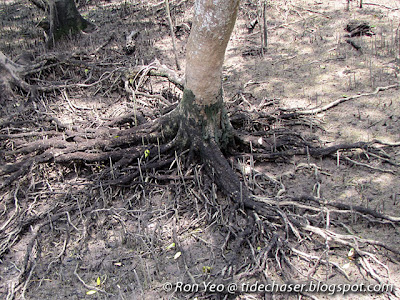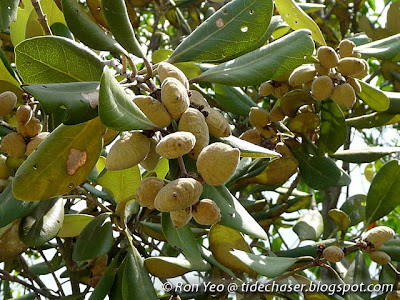The Api-api Bulu (Avicennia rumphiana) is a nationally common mangrove tree from the family Acanthaceae. It is also commonly called Avicennia lanata. "Api-api" means "fire-fire" or "firefly" in Malay, as some Avicennia species are noted to attract fireflies.
It is commonly found in most, if not all, the mangrove forests of Singapore, and usually occurs on the seaward side of mangrove forests at sheltered shores or estuaries. This is the largest Avicennia species, and huge trees up to 20m tall can be found in many areas, including easily accessible areas like the mangrove boardwalk at Sungei Buloh Wetland Reserve.
The bark is dark grey or brown. Like other Avicennia species, it has pencil-like aerial roots (pneumatophores) to help the plant breathes air, which is scarce in the waterlogged soil. The roots spread over a wide area to help stabilise the tree on the unstable ground. These roots reportedly also trap sediments and hence reclaim land naturally.
Research indicated that roots of Avicennia species also exclude salt from entering the plant. For some species, salt filtration by the roots is by far the most important salt-rejecting mechanism, excluding up to 80% of the salt carried towards the root surface by the transpiration stream.
It has simple, opposite leaves with rounded tips. They are dark green on the top side.
The underside is light-brown, covered with fine hair that conserve water by trapping a layer of insulating air and thus reduce water loss through evaporation. Salt glands on the underside of the leaves excrete part of the remaining quantity of salt which was not excluded at the roots.
Like the other Avicennia species, it has small yellow flowers, occurring in clusters.
The fruits are broadly ovate, covered with short hair, giving it a furry appearance and hence the Malay name "bulu", which means "fur". The plant exhibits cryptovivipary - the embryo grows to break through the seed coat but not the fruit wall before it splits open. Occasionally, vivipary is also observed, where the embryo grows and break through the seed coat and the fruit wall while still attached to the parent plant.
The wood is used for construction and as firewood. The seeds are cook and eaten in some places.
References
- Chong, K. Y., H. T. W. Tan & R. T. Corlett, 2009. A Checklist of the Total Vascular Plant Flora of Singapore: Native, Naturalised and Cultivated Species. Raffles Museum of Biodiversity Research, National University of Singapore. Singapore. 273 pp.
- Drennan, P., & N. W. Pammenter. 1982. Physiology of salt excretion in the mangrove Avicennia marina (Forsk.) Vierh. New Phytol. 91:597-606.
- Giesen, W., S. Wulffraat, M. Zieren & L. Scholten. 2006. Mangrove guidebook for Southeast Asia. RAP Publication 2006/07. FAO Regional Office for Asia and the Pacific & Wetlands International. Bangkok. 769 pp.
- Ng, P. K. L., and N. Sivasothi. 1999. A guide to the mangroves of Singapore 1 : the ecosystem & plant diversity. Singapore Science Centre. Singapore. 168 pp.
- Scholander, P. F., H. T. Hammel, E. Hemmingsen, & W. Garey. 1962. Salt balance in mangroves. Plant Physiology. 37:722-729.
- Waisel, Y., A. Eshel and M. Agami. 1986. Salt balance of leaves of the mangrove Avicennia marina. Physiologia Plantaruma. 67:67--72.

No comments:
Post a Comment